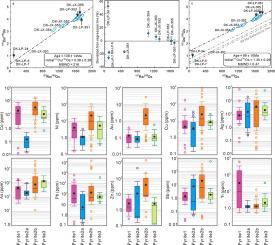Ore Geology Reviews ( IF 3.2 ) Pub Date : 2021-04-29 , DOI: 10.1016/j.oregeorev.2021.104202 Meng-Ting Chen , Jun-Hao Wei , David Selby , Yan-Jun Li , Wen-Jie Shi , Yu-Jing Zhao

|
The Dongji (>12.5 t Au @ 4.27 g/t) and Maluntou (>5.0 t Au @ 3.70 g/t) gold deposits are the two largest ones in the Dongkeng Volcanic Basin (DVB), SE China, that are hosted by volcanic rocks. Mineralization is represented by three stages (i.e., stage 1, 2, and 3) that are characterized by four types of unzoned hydrothermal pyrite (i.e., pyrite1, 2a, 2b, and 3). Hydrothermal fluids responsible for pyrite1 deposition are moderate temperatures (308–377 °C) and low salinity (4.6–9.1 wt% NaCl equiv.). The deposition of pyrite2a and 2b is related to the stage 2 fluids featured by moderate-low temperatures (253–341 °C) and low salinity (3.2–9.1 wt% NaCl equiv.). Pyire3 is deposited from the stage 3 fluids with low temperatures (220–250 °C) and salinities (1.0–6.5 wt% NaCl equiv.). Hydrothermal fluids potentially have a magmatic origin and experience fluid boiling and mixing of meteoric water.
Scanning electron microscopy and laser ablation inductively coupled plasma-mass spectrometry were used to investigate the occurrence of visible gold and the distribution of invisible gold in pyrite from different generations. Visible gold mainly exists as native gold and electrum within crystal interstices, fractures, and hollows of pyrite2b, and precipitates directly from the fluids during fluid boiling at ca. 329 °C with pressure of ca.120 bar. Invisible gold mainly presents in the form of solid solution in all pyrite types. Solid solution gold is also closely related to pyrite2b as the measured Au concentrations in pyrite2b (up to 27 ppm) exceed those in other pyrite types (<0.6 ppm) by one or two orders of magnitude. The elevated content of invisible Au (together with As, Ag, Zn, and Sb) in pyrite2b is potentially associated with lattice dislocations caused by rapid precipitation of Py2b during boiling process.
The Re–Os isochron age of pyrite2b (99 ± 10 Ma) and the zircon U–Pb dating of the volcanic and subvolcanic rocks (95.1–104 Ma) indicate that the formation of gold mineralization and the igneous activity in the DVB were coeval during the Turonia–Albian. Geochronology, fluid characteristics, together with low Ni concentrations (<98 ppm) and high mean Co/Ni ratios (≥2.0) of pyrite from different generations, support that the Dongji and Maluntou gold deposits formed in a magmatic-hydrothermal ore system and have an intermediate-sulfidation epithermal origin.











































 京公网安备 11010802027423号
京公网安备 11010802027423号